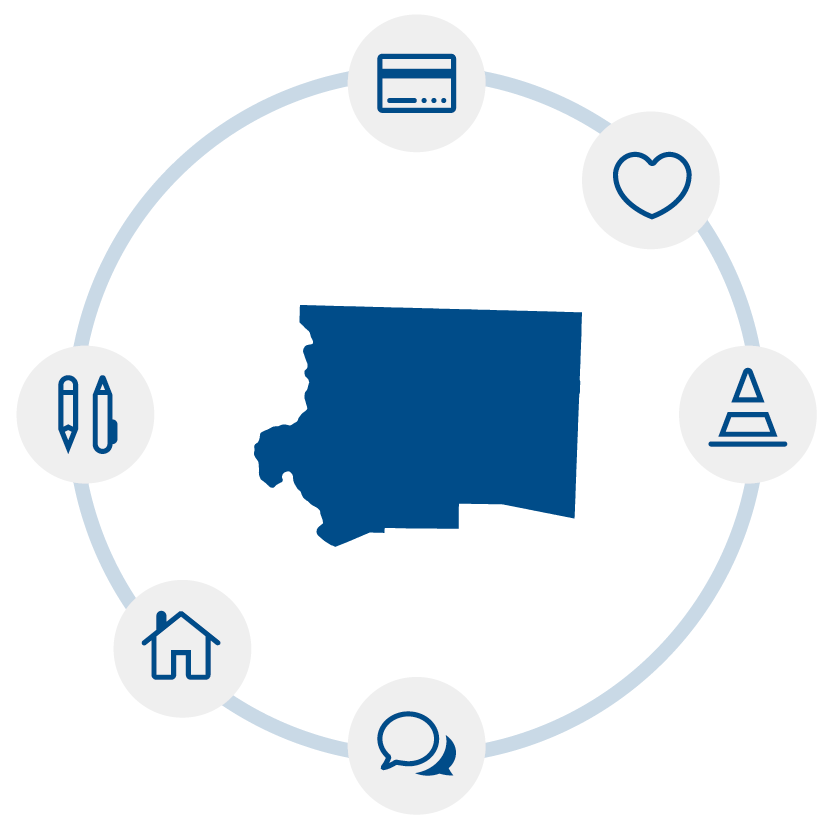Community Data
Demographics
Reliable local data encourages and supports data-informed decision making by community stakeholders at all levels. This information is designed to simplify the process of using data to inform the work that moves our community forward — program planning and evaluation, funding and resource allocation, grant writing, and more. If you have questions, please contact [email protected].
Demographics
Demographic data includes information on Forsyth County’s population as well as sub-populations within the county based on factors such as geography, gender, age, and race/ethnicity.
If you have questions, please contact [email protected].
Population by Count and Percent
Population by Geography
Population by City
Demographic Data Sources
- United States Department of Health and Human Services (US DHHS), Centers for Disease Control and Prevention (CDC), National Center for Health Statistics (NCHS), Bridged-Race Population Estimates, United States July 1st resident population by state, county, age, sex, bridged-race, and Hispanic origin. Available on CDC WONDER Online Database. Accessed at http://wonder.cdc.gov/bridged-race-v2020.html on December 12, 2021.
- U.S. Census Bureau (2020). ACS Demographic and Housing Estimates: Table DP05, 2015-2019 American Community Survey 5-Year Estimates. Retrieved from data.census.gov.
Demographics
Demographic data includes information on Forsyth County’s population as well as sub-populations within the county based on factors such as geography, gender, age, and race/ethnicity.
Total Population
By Count
By Percent
Map
Population by Subgroup
Age
Sex
Race/Ethnicity
Population by City
By Count
By Percent
Demographic Data Sources
- United States Department of Health and Human Services (US DHHS), Centers for Disease Control and Prevention (CDC), National Center for Health Statistics (NCHS), Bridged-Race Population Estimates, United States July 1st resident population by state, county, age, sex, bridged-race, and Hispanic origin. Available on CDC WONDER Online Database. Accessed at http://wonder.cdc.gov/bridged-race-v2020.html on December 12, 2021.
- U.S. Census Bureau (2020). ACS Demographic and Housing Estimates: Table DP05, 2015-2019 American Community Survey 5-Year Estimates. Retrieved from data.census.gov.
Reports and Briefings
This section contains various reports that are relevant to community demographics. Listed reports may have been produced by Forsyth Futures or others in the community.
If you have questions, please contact [email protected].
2020 Key Measures Report

Produced by Forsyth Futures.
Forsyth Futures’ Key Measures Report serves as a compilation of recent, commonly-requested, community-specific, reference information to aid informed public consideration and grant-writing activities in Forsyth County. The contents of this report address demographics and various topics related to the economy, health and wellness, education, and safety in Forsyth County.
Age-Friendly Forsyth 2017 Community Report

Produced by Age-Friendly Forsyth in partnership with Senior Services Inc. and Forsyth Futures, 2017.
When you think of an age-friendly community, what comes to mind? What needs to be improved to make Forsyth County the place to live your best life? We set out to answer these questions in the first phase of Age-Friendly Forsyth, a collaborative community effort that focuses on optimizing opportunities and enhancing quality of life as people age. The full report is the culmination of a year-long effort, involving many community residents and organizations, to collect views and perspectives on aging in Forsyth County. This is a snapshot of where we are now, and it establishes a baseline from which we can measure future growth.
Demographic and Workforce Data Request
Produced by Forsyth Futures, 2016.
Information was requested on Winston-Salem/Forsyth County demographics and workforce. The request was specifically interested in information on the following: educational attainment by race/ethnicity, unemployment levels by race, drop out rates by race, average salary/household inccome by race, and other high-level employment and workforce data broken out by race/ethnicity for the Winston-Salem/Forsyth County.
Community Research Framework
Individual Forsyth Futures reports are generally written to provide focused information on specific issues to inform community action. While these topics are generally measured in separate reports for clarity, it is important to acknowledge that all of the local issues we study are interconnected. For example, food insecurity is generally measured separately from reading proficiency scores, but in reality being a part of a family experiencing food insecurity can have a significant impact on children’s ability to learn and be successful in school.
Two Complementary Frameworks
To guide our reporting as we navigate this complexity, Forsyth Futures uses two frameworks which consider interconnected topical dimensions and dimensions of context and scale, respectively. Taken together, these two frameworks provide an opportunity for community stakeholders to consider how issues that appear separate in their reporting may be interconnected.

Interconnected Topical Dimensions
This framework model shows that despite how topics are separated to make information easier to access and communicate, many of the sectors that we study are interconnected, like a student’s economic stability and their ability to be successful in school.
Built and Physical Environment
Economy and Financial Stability
Education
Health and Wellness
Safety
Social and Civic Environment

Dimensions of Context and Scale
This framework model is based on a commonly-used social determinants of health model called the Social-Ecological model. This model illustrates how individuals and families are impacted by the broader contexts in which they exist. For example, an individual child’s test score measures their reading proficiency at the individual level, but it is important to acknowledge the impact that a child’s family, neighborhood, and school have on the child’s success.
